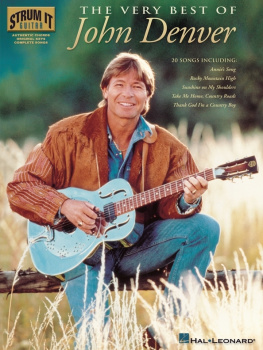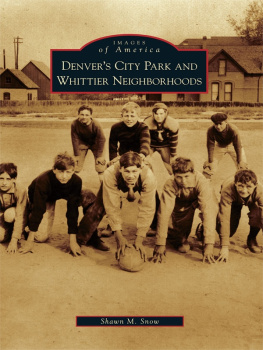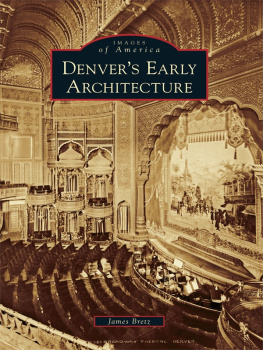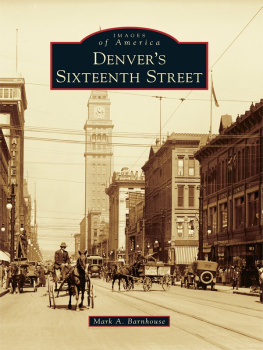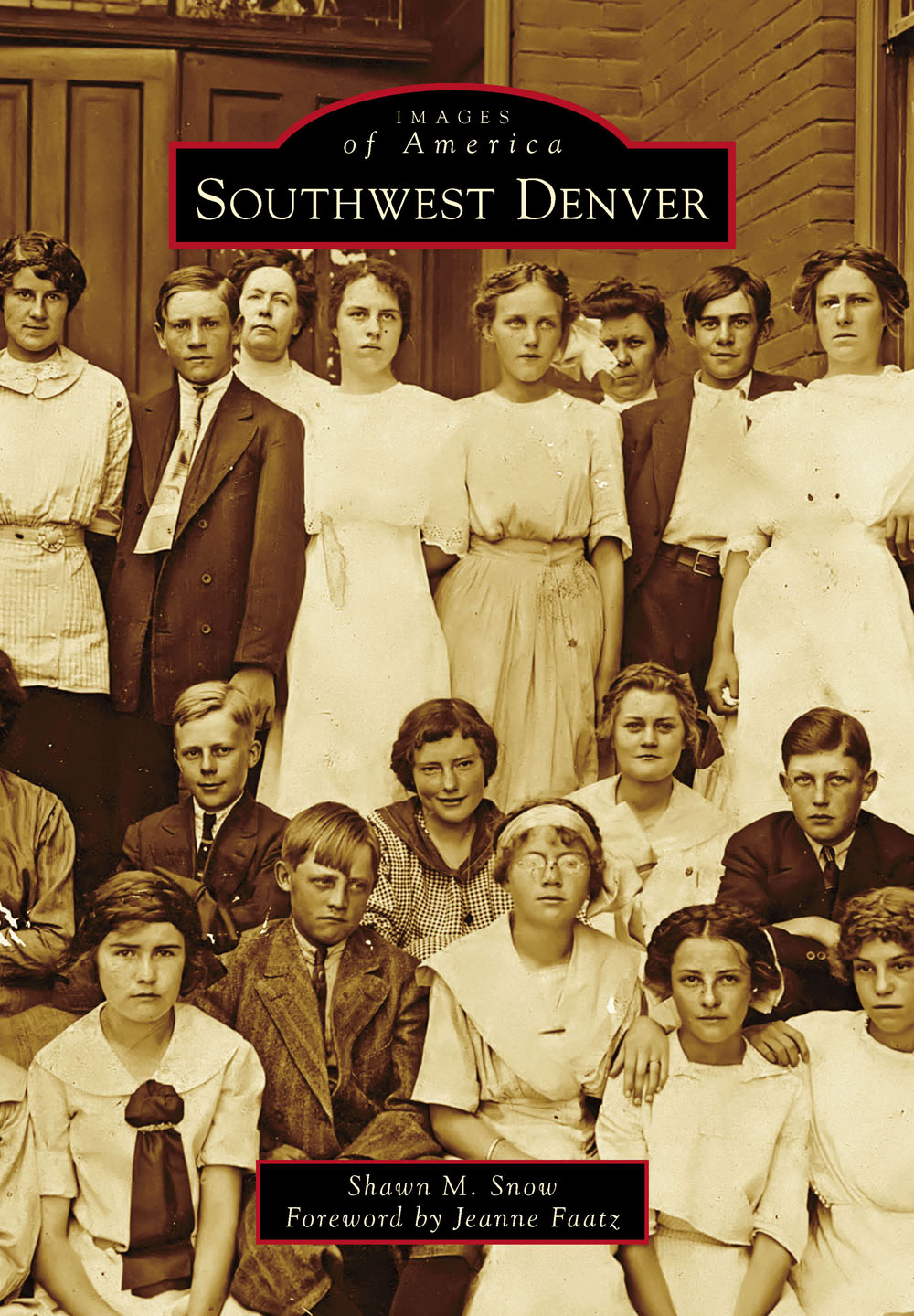
IMAGES
of America
SOUTHWEST DENVER

FROM DENVER TOWARD THE SOUTHWEST, 1908. In this photograph, a newly ascendant Denver reigns supreme over the land, having triumphed in a battle to absorb surrounding towns into a consolidated city and county government on November 15, 1902. At that time, even city leaders could not have imagined that a half century later, Denver would set its sights toward Loretto Heights, seen here rising in the distance, seven miles from the capitol building, from where this photograph was taken. In the foreground, Lincoln Street stretches southward with St. Marks Church and its Norman tower at Twelfth Avenue. A dominant Denver General Hospital is in the middle at Sixth Avenue and Broadway. (Denver Public Library Western History Collection.)
ON THE COVER: Taken in 1913, this photograph of the eighth-grade graduating class of the Valverde School includes Claude James C.J. Allen, standing in front of and just to the left of his teacher. Their school was perched on a hill southwest of present-day South Navajo Street and West Exposition Avenue in a building that had been constructed in the town of Valverde in 1890. Allen witnessed Denver annex the once separate town of Valverde by 1902 as the city grew in all directions. The new city and county of Denver would lie dormant until 1941 when it began to expand quickly, especially southwestward. (Authors collection.)
IMAGES
of America
SOUTHWEST DENVER
Shawn M. Snow
Foreword by Jeanne Faatz

Copyright 2016 by Shawn M. Snow
ISBN 978-1-4671-2406-5
Ebook ISBN 9781439658741
Published by Arcadia Publishing
Charleston, South Carolina
Library of Congress Control Number: 2016949275
For all general information, please contact Arcadia Publishing:
Telephone 843-853-2070
Fax 843-853-0044
E-mail
For customer service and orders:
Toll-Free 1-888-313-2665
Visit us on the Internet at www.arcadiapublishing.com
To the good people of southwest Denver
CONTENTS
FOREWORD
In 1968, my family discovered southwest Denver. It was time to buy a house. The same Hutchinson ranch home, built in several subdivisions in the Denver area, sold for nearly 10 percent less in the southwest area than in the southeast. Moreover, southwest Denver emphasized families. It had more churches than bars. Convenience to good schools, grocery stores, and diverse retail and a theater added to its attractiveness.
Overall, southwest Denver has been an extraordinary place to live and raise a family. It has strong neighborhoods, homes on large lots, nearby schools, and beautiful parks. From the beginning, community members sought activities for children and parents, boosting the areas vitality and cohesion. The YWCA Y-Wives program, with over 100 adult members, rented church space to offer classes for women and a play school for their young children. Also, the YMCA leased southwest Denver parkland to build a new facility, then a unique arrangement for the city. Two court decisions temporarily set back momentum. Court-ordered de-annexation of Governors Ranch and Westridge and court-ordered Denver school desegregation with mandatory busing caused logistical challenges for many residents. The former upended plans of Denver city workers who purchased homes to comply with Denvers residency rule. The latter upset many families whose children could no longer walk to their neighborhood school. Some moved to other cities.
Through pictures, Shawn Snow has documented the rise of southwest Denver, including these stories and a wide variety of other events, helping to tell the history of southwest Denver from 1880 to 1980. For as long as I have known him, he has expressed keen interest in land use policy and historical events. Annexation was one such crucial issue. In my role as Denver city councilwoman, I benefited from his exceptional understanding of boundary changes and the impact on residents.
Today, southwest Denver has a resurgence of young families. It remains one of the most affordable areas in Denver. I am grateful Shawn Snow has shown how the past decades have contributed to the remarkable development of our beloved southwest Denver.
Jeanne Faatz
State representative, District 1, representing southwest Denver, 19791998
Denver city councilwoman, District 2, representing southwest Denver, 20032015
ACKNOWLEDGMENTS
Writing this book has been an odyssey of fits and starts over the past decade. The history contained herein is considered as non-history by some because it does not generally cover anybody famous or particularly cover dramatic points in time. It is, in its truest form, the story of everyday people and places with narratives that have been hidden in closets, boxes, and albums and not always in library archives or newspapers. It has come together by adding everything up that I could find and then weaving a story into a cohesive narrative with the pictures at hand into the story of southwest Denver. It is an important story.
The completion of this volume would not have been possible without the considerable attention and assistance provided by Michael Vincent and Aaron Marcus. You two believed in my vision and never said no in providing technical and research assistance as well as encouragement. To you, I am forever indebted, as this book was not easy to put together. My urban planning comrade of 20 years, Ken Schroeppel, produced the wonderful maps in this book. Photographer Minka Ricker took the modern photographs for this volume to help round out the story, especially when no historical photographs could be found. In addition, the late Ivan Rosenberg, publisher of the Southwest Denver Herald Dispatch, kindly responded to my insistence that his warehouse might contain old boxes of photographs from his newspaper. We found some, and this book benefited from his kind donation of his lifes work. And after digging in every nook and cranny I could think of across southwest Denver, I ended up with too many pictures. Editing photographs down was painful, but the treasure trove of images I eventually did assemble would not have been possible without the kind assistance and vision of the following individuals, in no particular order: Jack Ballard, Bonita Hutcheson, Regina Drey SL (Sisters of Loretto), Elizabeth Cook, Holly Geist, Melissa VanOtterloo, Laura Ruttum Senturia, Laura Meeks, Coi Drummond-Gehrig, Vickie Makings, David Forsyth, Atom Stevens, Diane Snow, Kevin Snow, Jim Peiker, Louis Feher-Peiker, Brother Emmett Sinitiere and Brother George Van Grieken, Clare Harris, Neal Bamesberger, Robert Vanliere, Marilyn Douglas, Sue Atkins, Newell Grant, Tom Noel, Judy Durzo, Ellen Daugherty McMichael, Mary Taft, Christopher Erskine, Ross Webster, Ryan Mulligan, Sheryl Sullivan, Karen Wilborn, Melvin G. Garcia, Lynda Heckendorn, Lyle Miller, Ginger Reichert, David Weist, Jeanne Faatz, Dana Montano, Kevin Flynn, William Marlowe, Natalie Shilstut, Michael Collins, Patricia McKinnon, Judi Wright, Win Ferrill, Bob Charles, and Bill Arndt.
Many pictures in this volume can be attributed to the following: the Denver Public Schools (DPS); Denver Water (DW); Denver Post (DP); Denver Public Library Western History Collection (DPL WHC); History Colorado (HC); authors collection (AC); De La Salle Institute Archives, San Francisco/New Orleans District, Napa, California (DLSI); Grant Family Photos, All Rights Reserved (GFP); Archives and Special Collections, Regis University, Denver (RU); Minka Ricker Photography (MRP); Mary Taft collection (MTC); Good Shepherd Lutheran Church (GSLC); Mulligan family collection (MFC); Presbyterian Historical Society (PHS); and the
Next page

